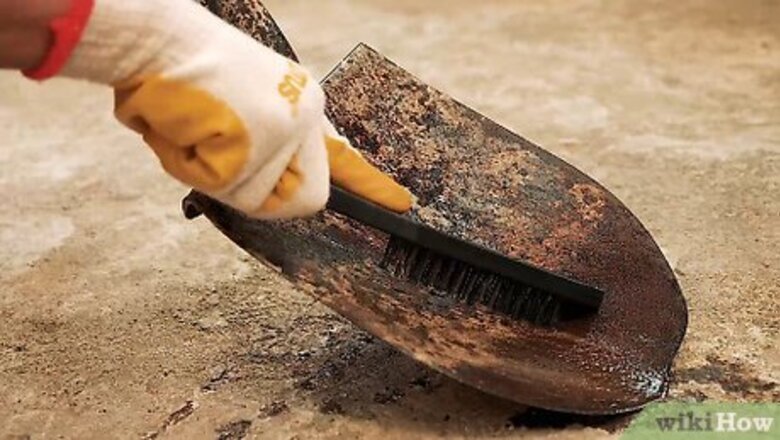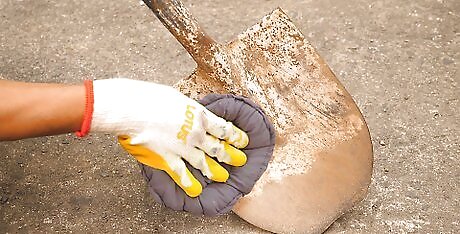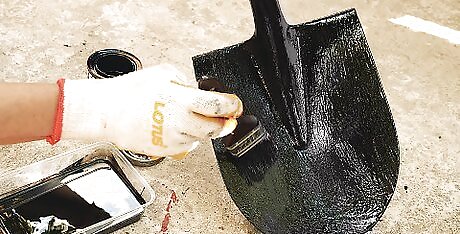
views
- Use a wire brush and fine-grit sandpaper to remove rust, dirt, and debris from the metal surface before painting.
- Coat the metal surface in an oil-based primer designed for metals to help your paint job last longer.
- Apply at least 2 coats of a metal paint for a bold and smooth paint job.
Removing Rust and Dirt

Remove old paint, rust, and dirt from the surface with a wire brush. Rust, dirt, and paint can clump onto a metal surface over time. Use a wire brush to strip unwanted debris from the metal. After a few scrapes, wipe the loosened particles away with a damp rag or cloth. Keep scrubbing and wiping until all the rough clumps are removed. If you don’t have a wire brush, use a fine-grit sandpaper or sand block. Focus on stripping larger areas with your wire brush, as you can work on the nooks and crannies later when sanding the metal piece. Try using a cordless drill with a wire brush attachment to make the process that much quicker. Work in a ventilated area and wear gloves and a dust mask when working with paint and rust to protect yourself from harmful particles. Consider using a drop sheet to cover your work station to keep it clean.

Rub the surface of the scraped metal with mineral spirits or a degreaser. Wipe away all the remaining paint dust and rust particles with a cloth or rag dipped in a metal degreaser or mineral spirits. This will remove any leftover grime and give you a clean surface to work with. Even if the surface looks fairly clean, don't skip this step; otherwise, the paint may not stick to the metal properly. If you’re painting something made of galvanized steel, wash it down with white vinegar to break down leftover zinc from the galvanization process. This will help the paint adhere stick to the metal better.
Scrub the metal with fine-grit sandpaper until it’s smooth. Sanding the metal before you start painting ensures you get the longest life out of your paint job. Scuffing up the metal smooths it out and creates microscopic ridges the primer and paint can adhere to. After sanding, wipe down your metal with a damp cloth to remove any lingering debris.
Applying Primer and Paint
Apply a coat of an oil-based paint primer to the metal. Pick a primer specific for metal (these are typically oil-based). These adhere best to metal surfaces, helping your paint job last longer. Choose a spray primer or one you brush one—whichever works best for you. Paint or spray the primer on and let it dry for at least 24 hours. Always read the instructions on your primer, as there may be specific information on application or drying time. If your metal is rusted, apply a zinc-chromate primer before the oil-based primer. This primer resists corrosion and helps protect metal from further rust. Primer prepares a surface for paint by creating a smooth surface it can adhere to.

Cover the surface with a metal specific paint and let it dry. Use a bristle paintbrush or a paint roller to paint a thin coat over the surface of the metal. Be careful not to use too much paint as this could cause your paint job to look clumpy. Wait at least 90 minutes for the first coat to dry. Oil-based paints work best on outdoor items that will experience lots of weathering. They’re pigmented and water-resistant but can crack and chip easily over time. Acrylic-based paints dry fast and their toxic-free formula makes them perfect for indoor use. They’re durable but aren't water-resistant. Spray painting metal is another option that can give a smoother, cohesive finish. Read the instructions on your paint before painting, as there may be helpful information about application and drying time.

Apply another coat of paint to the metal. If your paint job looks streaky or isn’t as bold as you’d like, add another coat. Follow the brush strokes you used before. Wait between 36 and 48 hours for the paint to cure completely. Try to avoid moving your metal piece before it’s completely dried; otherwise, the paint may crack or peel prematurely. Consider applying a coat of clear sealant after the metal has dried for added protection. An extra seal can help the paint job last longer, chip less, and be waterproof.




















Comments
0 comment